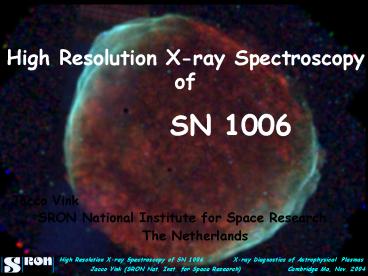High Resolution X-ray Spectroscopy of SN 1006 PowerPoint PPT Presentation
1 / 20
Title: High Resolution X-ray Spectroscopy of SN 1006
1
High Resolution X-ray Spectroscopy of
SN 1006
Jacco Vink SRON National Institute for Space
Research The Netherlands
2
Supernova Remnant Plasma Physics
- X-rays from SNRs are interesting for many
reasons - Studying the supernova phenomenon
- - nucleosynthesis (bulk mass visible in X-rays,
alpha elements) - - explosion energy and asymmetries
- Studying the interaction with the CSM/ISM
- Studying plasma/shock physics
- - high Mach number collisionless shocks
- - cosmic ray acceleration (prime sources up to
1015 eV?) - - influence of cosmic rays on plasma (energy
drain) - - physics of hot, thin plasmas
- Knowledge of plasma physics is a prerequisite
for point 1
3
Physics of SNR Plasmas
4
Non-Equilibrium Ionization (NEI)
(oxygen)
Collision Ionization Equilibrium
He-like
NEI
SN 1006
Tycho
Cas A
5
Temperature Non-equilibration
For strong shock, neglecting cosmic
ray sinks kTi 2(?-1)(?1)-2 mi vs2
3/16 mi vs2 (for ? 5/3)
6
Why SN1006?
- young (1000 yr) and low density (0.1 ions/cc)
- ionization and equilibration scale with net
- for SN 1006 3 x 109 cm-3s
- cf Cas A net gt 1011 cm-3s
- (ionization and temperature equilibrium net gt
1012 cm-3s) - Optical/ UV spectroscopy indicates temperature
- non-equilibration
- (Laming et al. 1996 Ghavamian et al 2002)
- High Mach shock gt3000 km/s
- Interesting historical, supernova remnant
7
SN 1006 some background
- SN 1006 aka G327.614.6 (NB high latitude!)
- bright (lt-6 mag) guest star in AD 1006
- recorded in Middle East, Asia Europe
- likely to be Type Ia (but lack of observed Fe)
- distance 2.1 kpc (Ghavamian et al. 2002,
Winkler et al. 2002) - 30 arcmin diameter
- Average velocity 9375 km/s
- Absorption column NH 7 x 1020 cm-2
- First shell remnant for which
- X-ray synchrotron emission was
- established (Koyama et al. 1995)
8
XMM-Newton's Reflection Grating Specrometers
(RGS)
- Three telescopes - Two gratings - No slit,
spectral degradation ?? 0.124( ?f/1') Å
9
Observational Strategy
Knot size lt 1 arcmin (0.4 arcmin FWHM)
Spectral resolution for bright lines e.g OVII
(22Å) gt 1/170
10
RGS Spectrum
11
Low charge state of neon
Ne Ka (RGS 2 order 1) measured centroid 13.78 /-
0.06 Å cf Ne IX w 13.44 Å, z 13.70
Å So not in Ne IX like state or unusually large
f/r ratio
12
EPIC (CCD) spectra
13
Constraining NEI
14
The OVII Thermal Broadening
15
OVII higher order lines
16
The Spectrum of the Eastern RimHopeless for the
RGS or perhaps not?
Pointing
17
The Shell Velocity of SN 1006
18
O VII He-like triplet
Based on rates calculated by M. Gu
19
Summary
- XMM's RGS allows high resolution spectroscopy of
- 1 arcmin sized objects, or larger if small
details are present - Many lines resolved that cannot be seen in
- CCD spectra, e.g. N VI,O VII n4,5,6 -gt n1
- No evidence for FeL lines, due to low ionization
- Plasma far out of ionization equilibration net
2 x 109 cm-3s - CCD/RGS spectra K line not always from He-like
- ionization state (Ne, Mg, Si), but due to inner
shell processes - Slow temp. equilibration of electrons and ions
in NW - kTe 1.5 keV and kTOVII 500 keV
- Evidence for 6000 km/s shell velocity in East
Results published in J. Vink, J.M. Laming, M.F.
Gu, A. Rasmussen, J. S. Kaastra Astrophysical
Journal Letters 587, L31 (2003)
20
RGS Spectra
(Expected Fe XVII)

